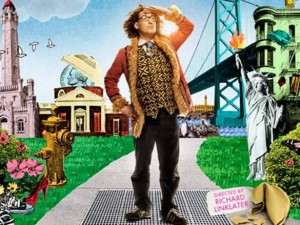The happy historian (Part 1): Are you up to speed?
28 December 2012 – Liz Almlie
There’s a show on the website Hulu you may have seen, called “Up to Speed” with host Timothy “Speed” Levitch and director Richard Linklater. Speed is a licensed tour guide—kind of—advising us that “to truly travel is to appreciate the beauty in the unexpected.” The show takes viewers on the magical history tours we all secretly dream about. His tours are not constrained by a route, by chronology, or by the fact that inanimate objects can’t talk. We go to “hang-out and empathize with the inner psyches of famous landmarks and visit with the great monumentally-ignored monuments,” because “why the f#@! not?”
Each episode of “Up to Speed” has a broad theme—aimlessness, self-perception of reality, labor & activism, boundlessness, etc. Each stop is a great story, magically and historically told, and most can lead easily into critiques of traditional heritage tourism. The show tells stories through cartoon illustrations, animated historic images, and dubbed-over conversations with the monuments (or museum objects, or trees). The stories celebrate creative experimentation and aimless exploration, question the value of artificial historical villages and automated tour guides, cover tragedies as a part of the human experience, and muse philosophically about human nature. They are case studies in memory, authenticity, significance, curation, interpretation, performance, and the sanctity of History. In helping others engage with and understand our shared past, do we expect them to memorize the minutiae, or expect their daily life to be changed by a grand detached narrative? Or is deep connection more about emotions, tactile experience, unexpected discoveries, and new perspectives?
In the Kansas-Missouri tour, the Burnt District Monument, a surviving chimney from the burning of towns evacuated under Union orders, talks to the tour group about the atrocities perpetrated during the Civil War by both sides—to remember what others choose to forget. Then, we overhear the building divas at Oskaloosa’s “Old Jefferson Town” fight and swear at each other about being moved into a diorama/nightmare/awkward-taxidermy/parody of a town—“can’t you curb your Napoleonic complex for even one second!” [It’s super entertaining.] Visiting a monument at the mass grave filled after Quantrell’s raid on Lawrence, Speed begins the story sharing that the extremist Quantrell “is a good example of someone who could’ve really used therapy” and ends with a heart-melting reflection on the human plague of bitterness. In his quest for the monumentally-ignored, Speed ends the episode by saying hello to a random cannon that literally has no plaque, no provenance, and no one to show it some love.
In San Francisco, Speed takes his tour group around the “City Shaped by Earthquakes,” visiting the Gold Fire Hydrant, the House of Falling Furniture, Parking Spot Park, the Dewey Monument with its muse Alma Spreckels, a Redwood “botanical diva,” the Bay Bridge with its Emperor Norton the First, the Embarcadero, and the Shoe Garden of Alamo Park. The Chicago tour visits the old and new Haymarket Square Riot memorials, the Insane Ancient Roman Column (the Balbo Monument), the doorknob of the Dill Pickle Club and the landscaping of Bughouse Square—both former bastions of free speech, and various landmarks of the lost neighborhood of Hobohemia. In other rich episodes, Speed shows groups around Monticello, New York City, and takes a tour of tour guides.
Relatively new to the professional world, I sometimes get so bogged down in the office-ness of budgets and grant administration and databases… ugh. It may be a cliché, but “Up to Speed” reminded me to enjoy the ride. Let yourself wander. Remember that people are bizarre, but they are also precious.
If we lived in the mindset of creative passion, of cherishing the human experience, how would it change the way we work as public historians? How do we share the story? What is it that really connects people to historic places, objects, and stories? We develop a sense of place when we dwell. We explore and make it our own. We care when it becomes a part of our lives. Should “hang out and empathize” become an approach to interpretation?
I think that watching “Up to Speed” made such an impression on me because it reminded me of the creativity and love that comes from connecting with the grand continuum of history in our everyday world. The good, the bad, the crazy, and the frivolous—they all show us what it means to be human.
Part 2 follows.





1 comment